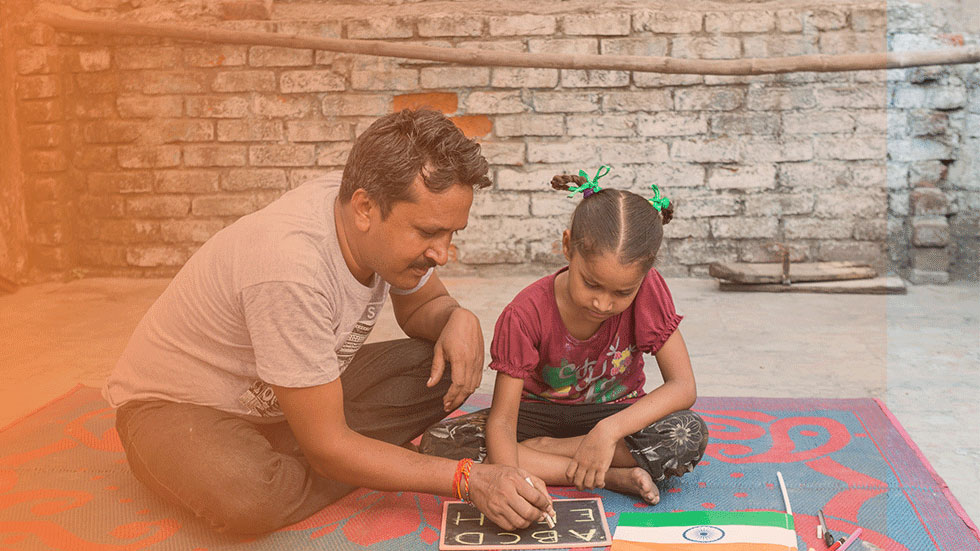Establishing The Basics: Literacy And Numeracy At The Foundation Level

Give Your School The Lead Advantage
Listening, speaking, reading, and writing (LSRW skills) are the fundamental skills that children learn at every stage. A child’s development of these skills begins from their parents, long before they start school. Literacy and numeracy development is embedded in everyday communications, actions and thoughts. But, what do we mean by early literacy and numeracy? How to establish the basics? And, finally, how to bridge the kindergarten and primary school gap going forward?
Literacy – Not Just Letters And Words
Literacy goes beyond the words used in language and communication, while its development starts from birth. It also includes non-verbal communication like pointing, smiling, and gesturing. In many Indian schools and households, knowledge means using extensive vocabulary and the ability of explanatory talking, letter identification before the age of five, narrative and story understanding, understanding writing functions, knowing nursery rhymes etc.
Lower proficiency in literacy and language, greater difficulty children have in learning to read. Differences in children’s mother tongue, and cultures can affect literacy development.
Numeracy – Not just numbers
Numeracy is more than just the ability to use numbers. The National Education Policy (NEP) points out that close to five crore children currently in elementary school do not have foundational literacy and numeracy skills. It recommends that the curriculum-load in each subject be reduced to the essentials. This would make space for holistic discussion, and analysis-based learning.
With the rise of virtual learning, education has become digital and remote. Online learning is a solution that helps students continue education from the comfort of their homes with laptops or smartphones. Many schools are headed towards a completely online mode or blended learning (online-offline) modal in the era of social distancing. Teachers have moved to “flipped classrooms” in which students learn basic skills and knowledge at home, via video platforms, and then come for online school lectures to apply their learnings. Meanwhile, a classroom allows teachers to work on higher-level skills like analysis and evaluation. Although this isn’t a new idea, circumstances have now forced the adoption.
Another upside of digital teaching is that online teaching platforms allow teachers to see their students’ progress as they are writing. This allows for real-time feedback rather than waiting for the work to be completed and submitted. Some students, who had earlier avoided participation, are now stepping up. The quieter, more introverted students are now participating more because they aren’t pressured by their peers’ scrutiny.
Key Challenges Facing The Stakeholders In Exploring The New Normal In Teaching
Every policy is only as good as its implementation. Continually advancing technology has enabled novel applications in education. It’s creating new learning environments to suit the changing conditions and learner requirements.
1) Remote teaching/learning had always been an emergency solution, but, not anymore. The most challenging task for teachers has been how to reach, stay connected, and provide rich learning experiences and support for a significant percentage of students who do not have access to resources and care during these unprecedented times. Another challenge is reaching children with cognitive disabilities. Bridging the gap from kindergarten to primary students is a herculean task. Teachers are the seminal link in the education stakeholders’ network, but they will deliver no matter what comes their way.
2) Parents working from home now have the additional work of providing tech support or guidance in children’s schoolwork. It is difficult for them to juggle between meetings and household chores.
3) Most children in rural areas suffer from network problems and cannot buy gadgets. Since there are multiple languages spoken in India, constructing a platform suitable for them is a difficult task.
What literacy experiences should we provide in the current scenario?
Literacy experiences can be provided to the foundation level children in the following ways:
1) Oral language should be encouraged by talking to children about what is happening around them through puppets, talk shows etc.
2) Phonological awareness can be taught through audios, videos, and various phoneme activities.
3) Alphabet knowledge can be taught by exposure to an alphabet in their surroundings. References can be used like refrigerator magnets, building blocks or toys, storybooks, food packaging, hoardings, pamphlets, notices, signs, drawings, paintings, beads, clays etc.
4) Mark-making: Remember the days we used to write on the sand and salt? Writing or drawings or making marks on paper, sand, on a steamed window, dirty car windshield, salt, uncooked rice; are child’s first attempts. It provides a means for children to communicate their feelings and thoughts.
What numeracy experiences should we provide in the current scenario?
The role of all the stakeholders should be to encourage the children towards seeing numeracy in the world around them. The core content of a curriculum for young children/ foundation level children, therefore, should include the following:
1) During classes, numbers could be taught to them through rhymes, clocks, cell phones, calendars, money, calculators, keyboards, television, stories that have numbers in them etc.
2) Children can be provided with opportunities of counting in many contexts and purposes like in counting the numbers of dolls, idlis, candies, chairs, books etc. Also, when children observe adults counting out loud for a reason, they have a greater chance of grasping what they see. It can be taught through natural, commercial and art resources, and everyday household items.
3) Shapes and patterns can be explored through pattern walks inside or outside their homes or schools through curtains, clothes, gift wraps, footpaths, bricks, toys etc. Similarly shapes and spaces through arrangements of objects through wrapping, twisting, stretching, stacking etc. and working with three-dimensional objects.
4) Encouraging children to compare size, weight, volume and length of objects proves helpful. Even complex measures, including area and speed, may be discussed. These are all simple, doable, inexpensive ways to introduce literacy and numeracy to children at an early age. They can be achieved with or without fancy schools or technologies.
The NEP 2020 aims to universalize pre-primary education by 2025 and provide foundational literacy/numeracy for all by 2025. Foundational Literacy & Numeracy are also other top priorities of the new policy after recognizing the learning crisis in Language and Mathematics during the primary school years and its impact on attendance, retention and later learning.
Also, strategies for supporting biliteracy could be considered. The educators should respect and support for the diversity of children’s families, cultures and linguistic background since they are important in early literacy development. In other words, the socio-cultural context of children’s families should be included in the curriculum. The current crisis has presented a roadmap on how education could change for the better and the worse in the long term. Blended learning will be the new normal post-pandemic. Also, Indian education is so immensely diverse considering different boards like State, CBSE, ICSE etc. Our students have low performance in standard tests like PISA because the strategy that students use to solve questions in typical Indian exams is very different from what is needed for tests like PISA. Going forward, our education must concentrate on developing skills instead of just completing the course content.
We know that high-quality literacy and numeracy experiences right from the early years can positively impact a child’s later achievement. We require early childhood educators who are willing and able to continue professional development in early literacy and numeracy. Early childhood educators have a unique opportunity. They can get it right from the start at a crucial stage in children’s learning and development. This pandemic has made crystal-clear the importance of disseminating knowledge across all parts of society. If online learning technology can play a role here, it is binding upon us to explore its full potential. This too shall pass and the learning must and will go on! We are here to keep the optimism surging!
LEAD is transforming schools by making children future-ready. To make yours a LEAD Powered School: Partner with us today


